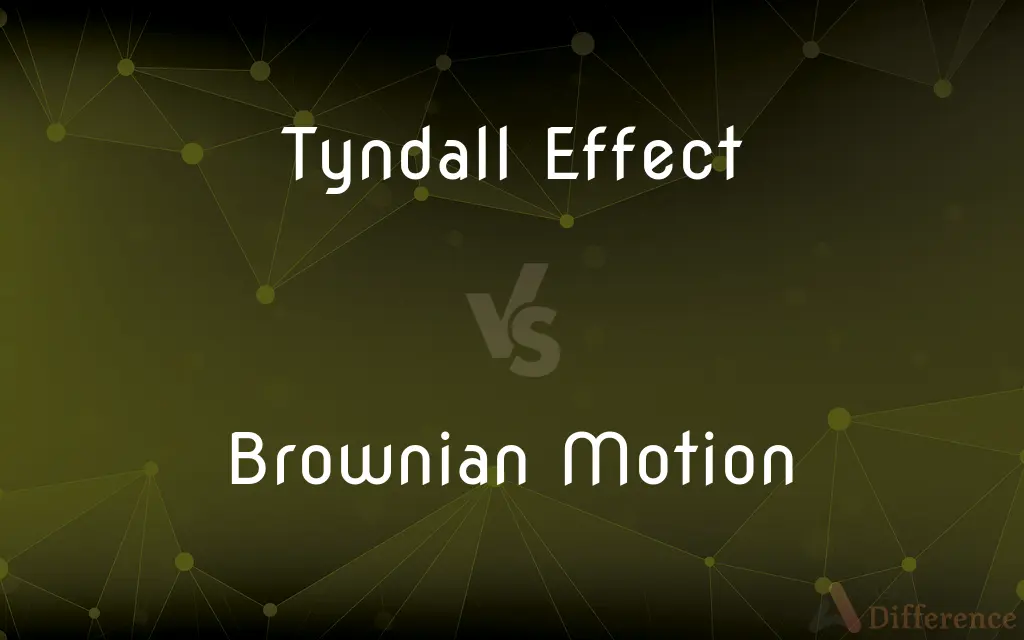Tyndall Effect vs. Brownian Motion — What's the Difference?
Edited by Tayyaba Rehman — By Fiza Rafique — Published on December 2, 2023
Tyndall Effect relates to the scattering of light by colloidal particles, while Brownian Motion describes the erratic, random movement of particles in a fluid due to collision with molecules.

Difference Between Tyndall Effect and Brownian Motion
Table of Contents
ADVERTISEMENT
Key Differences
The Tyndall Effect is a phenomenon in which light is scattered by particles in a colloidal solution, making a beam of light visible in the medium. Brownian Motion, on the other hand, is the unpredictable, jittery motion of particles suspended in a fluid caused by collisions with fluid molecules.
While the Tyndall Effect is often observed in mixtures like colloids where particles are big enough to scatter light, the Brownian Motion can be seen in both colloidal solutions and true solutions where minute particles are incessantly jostling.
The Tyndall Effect serves as a primary method to determine if a mixture is a true solution or a colloid. Brownian Motion serves as evidence for the kinetic theory, demonstrating that atoms and molecules are always in motion.
In the Tyndall Effect, factors such as particle size and wavelength of light play pivotal roles in determining the intensity and angle of scattered light. In Brownian Motion, temperature and viscosity of the medium influence the rate and pattern of particle movement.
The Tyndall Effect is solely an optical phenomenon and does not imply any motion of particles. However, Brownian Motion is directly related to the physical movement of particles.
ADVERTISEMENT
Comparison Chart
Nature
Optical phenomenon
Physical movement of particles
Visible In
Colloidal solutions
Both colloidal solutions and true solutions
Cause
Scattering of light by particles
Collisions with fluid molecules
Factors Influencing
Particle size, wavelength of light
Temperature, viscosity of medium
Utility
Determines true solution vs colloid
Demonstrates atoms/molecules are in motion
Compare with Definitions
Tyndall Effect
The scattering of light by particles in a colloidal solution.
When you shine a flashlight through milk, the Tyndall Effect causes the beam to become visible.
Brownian Motion
A demonstration of the kinetic theory in action.
Studying Brownian Motion offers insight into the perpetual movement of molecules.
Tyndall Effect
A test for distinguishing between colloids and true solutions based on light scattering.
Since the sugar water didn't show the Tyndall Effect, it was a true solution.
Brownian Motion
Unpredictable jostling of suspended particles.
The constant Brownian Motion ensures that tiny particles remain suspended in a liquid.
Tyndall Effect
An optical phenomenon making a beam of light visible in a medium.
The blue of the sky is partly due to the Tyndall Effect of atmospheric particles.
Brownian Motion
A phenomenon observed both in true solutions and colloids.
The Brownian Motion of gold nanoparticles can be observed in colloidal gold.
Tyndall Effect
Light diffusion by particles larger than the light's wavelength.
The foggy forest became a visual treat due to the Tyndall Effect when morning sunlight pierced through.
Brownian Motion
The erratic, random movement of particles in a fluid.
Under the microscope, the pollen grains exhibited Brownian Motion in water.
Tyndall Effect
The effect responsible for the diverse colors in opalescent substances.
The Tyndall Effect is the reason behind the shimmering blue in some gemstones.
Brownian Motion
Motion caused by collisions between particles and fluid molecules.
The rapid Brownian Motion of smoke particles helps prove the existence of atoms and molecules.
Common Curiosities
What is the Tyndall Effect?
The Tyndall Effect is the scattering of light by particles in a colloidal solution, making a light beam visible.
How is the Tyndall Effect different from Brownian Motion?
Tyndall Effect relates to light scattering, while Brownian Motion pertains to the physical movement of particles.
Does temperature affect Brownian Motion?
Yes, temperature can influence the rate and pattern of Brownian Motion.
Can the Tyndall Effect be observed in gases?
While typically seen in liquids, the Tyndall Effect can also be observed in some gaseous systems with suspended particles.
What causes Brownian Motion?
Brownian Motion is caused by collisions between the suspended particles and the molecules of the fluid.
What proves the continuous movement of molecules?
Brownian Motion serves as evidence for the continuous and perpetual movement of molecules.
Can Tyndall Effect be seen in true solutions?
No, the Tyndall Effect is typically observed in colloidal solutions, not true solutions.
Does the Tyndall Effect depend on the wavelength of light?
Yes, particle size and light wavelength influence the Tyndall Effect's scattering angle and intensity.
What is Brownian Motion?
Brownian Motion is the erratic, random movement of particles in a fluid due to collisions with fluid molecules.
Is the blue color of the sky related to the Tyndall Effect?
Yes, the blue of the sky is partly due to the Tyndall Effect of atmospheric particles.
Can Brownian Motion be seen with the naked eye?
Typically, Brownian Motion is observed under a microscope due to the tiny size of particles involved.
What role does viscosity play in Brownian Motion?
A higher viscosity medium can slow down the Brownian Motion of particles.
Why is the Tyndall Effect significant in colloid science?
It helps distinguish between true solutions and colloids based on light scattering.
Does the Tyndall Effect occur in pure water?
No, pure water doesn't display the Tyndall Effect as there are no particles to scatter light.
Why is Brownian Motion important in physics?
It supports the kinetic theory of matter and demonstrates the existence and motion of atoms and molecules.
Share Your Discovery

Previous Comparison
Grapes vs. Raisins
Next Comparison
Internet vs. World Wide WebAuthor Spotlight
Written by
Fiza RafiqueFiza Rafique is a skilled content writer at AskDifference.com, where she meticulously refines and enhances written pieces. Drawing from her vast editorial expertise, Fiza ensures clarity, accuracy, and precision in every article. Passionate about language, she continually seeks to elevate the quality of content for readers worldwide.
Edited by
Tayyaba RehmanTayyaba Rehman is a distinguished writer, currently serving as a primary contributor to askdifference.com. As a researcher in semantics and etymology, Tayyaba's passion for the complexity of languages and their distinctions has found a perfect home on the platform. Tayyaba delves into the intricacies of language, distinguishing between commonly confused words and phrases, thereby providing clarity for readers worldwide.













































